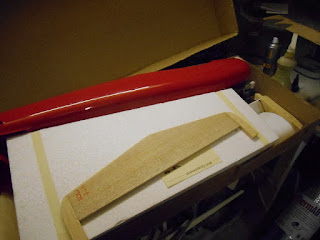Before I start though, I need a full set of wing ribs. These were supplied by LaserCraft Services for a reasonable fee, cut from DXF files that I supplied
The only straight edge that I can work from is the hinge line for the ailerons or just in front of it.
To make sure that it stayed straight, a wooden straight edge was screwed to the building board and the wing was assembled from that point.
So with the position of the false TE established, lines were drawn representing the rib positions.
A 1.5mm spruce false TE was cut and the ribs glued into place pushing back against the false TE. This was aligned to the upper edge of the ribs like this
Assemble the wing as you normally would
Note the false LE held in place by suitable weights and curving back as the ribs are fitted. It took a couple of sessions to get them all in place
The spar is laminated from 4 of 3mm square spruce strips at the root, tapering to 2 strips at the tip. A slight change from the plan. I originally intended to taper each spar backward - in the end, I used a stepped taper to get the correct fit, adjusting the spar slot in the rib until I get a nice snug fit.
This was the junction from 4 to 3 laminations with a slight taper on the outer spar
After the spar was fitted it looked like this, small 1.5mm gussets added at the rib/TE junction and then the wing was sheeted over - while the wing was still pinned down.
Left to dry/stabilise for 24 hours and then removed from the board and very quickly adding the lower spar and shear webs for the length of the panel
Don't forget to fit the servos. These are built in with no hatches, if a servo fails it will be surgery to replace it.
The servo bearers are cut from 10mm square pine (B&Q) and simply glued to the upper sheet. The servos then are located in a lite-ply frame and glued and screwed into place. Align the arms before you proceed, there is no easy return path if you this wrong.
The wing joining tube is fitted and thoroughly glued into place. The tube is glued against the webs - this makes a nice load transition from the aluminium tube to the spruce spars. The end stop is a 3mm off-cut of the joining tube epoxied into place
Add the lower sheeting (after removing the building tabs) and when dry, trim back to the false LE
The real LE comprises of a balsa laminate capped with a spruce laminate
The wing tips are laminated from 2 x 3/16 sheet balsa with a 1/32 ply core and glued into place
and the joint reinforced with a strip of Nylon - well soaked in PVA
The process was then repeated for the other wing half..



















